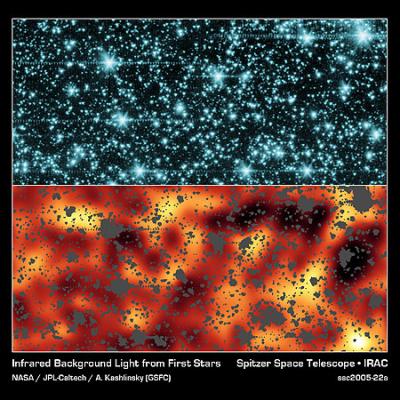The Spitzer Space Telescope once again dazzles us with its capabilities at infrared wavelengths. Now it’s the detection of what may be some of the earliest objects in the universe, the hypothetical Population III stars that would have formed a mere 200 million years after the Big Bang itself. These short-lived objects were probably over a hundred times more massive than our Sun. If the scientists investigating the recent Spitzer data are right, they are looking at the redshifted ultraviolet light of these ancient stars, stretched to lower energy levels by the expansion of the universe and now detected as a diffuse glow of infrared light.

Image: The top panel is an image from NASA’s Spitzer Space Telescope of stars and galaxies in the constellation Draco, covering about 50 by 100 million light-years (6 to 12 arcminutes). This is an infrared image showing wavelengths of 3.6 microns, below what the human eye can detect. The bottom panel is the resulting image after all the stars, galaxies and artifacts were masked out. The remaining background has been enhanced to reveal a glow that is not attributed to galaxies or stars. This might be the glow of the first stars in the universe. Credit: NASA/JPL-Caltech/A. Kashlinsky (GSFC).
Described in the November 3 issue of Nature, the detection of objects in the universe of 13 billion years ago is remarkable in itself, and so is the method the science team, based at NASA Goddard Space Flight Center in Greenbelt (MD) used to make the observations. We are talking about light that is far to faint to be resolved into individual stars. Spitzer was therefore used to take a ten-hour observation in the constellation Draco. The team then eliminated all known objects to study the far more ancient light left behind. Alexander Kashlinsky, an astronomer at NASA’s Goddard Space Flight Center in Greenbelt, Maryland, and a member of the team that made the discovery, calls this afterglow “…the repository of emissions for all stellar populations that have ever existed in the Universe.”
From a Spitzer news release:
“This deep observation was filled with familiar-looking stars and galaxies,” said Dr. John Mather, senior project scientist for James Webb Space Telescope and a co-author on the Nature article. “We removed everything we knew—all the stars and galaxies both near and far. We were left with a picture of part of the sky with no stars or galaxies, but it still had this infrared glow with giant blobs that we think could be the glow from the very first stars.”
And here is where the various scientific resources come together. NASA’s Cosmic Background Explorer had produced data suggesting an infrared background glow that was not associated with known stars. Later, the Wilkinson Microwave Anisotropy Probe’s 2003 data pointed to ignition of the earliest stars in an era between 200 and 400 years after the Big Bang. Now we can look forward to integrating the data from COBE, WMAP and Spitzer with upcoming information from the James Webb Space Telescope, which may one day resolve the first individual clusters of such stars.
Centauri Dreams note: It is important to emphasize that the new Spitzer observations reveal not individual stars but variations in background radiation that seem to point to star formation. Nonetheless, the data seem clean, as discussed in this nature.com article from which the above quote from Alexander Kashlinsky comes. In fact, the team found clusters in the background radiation in four different wavelengths in different parts of the sky and at different times of year, which seems to rule out local interference.
The paper itself is Kashlinsky, A., Arendt, R.G. et al., “Tracing the first stars with fluctuations of the cosmic infrared background,” Nature 438, 45-50 (3 November 2005). Also, Juan Cabanela at Saint Cloud State University (MN) offers a fine discussion of the first stars in terms of hydrostatic equilibrium.

